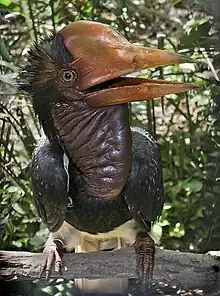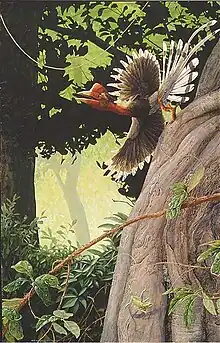| Helmeted hornbill | |
|---|---|
 | |
| immature male at the Jurong Bird Park. | |
| Scientific classification | |
| Domain: | Eukaryota |
| Kingdom: | Animalia |
| Phylum: | Chordata |
| Class: | Aves |
| Order: | Bucerotiformes |
| Family: | Bucerotidae |
| Genus: | Rhinoplax Gloger, 1841 |
| Species: | R. vigil |
| Binomial name | |
| Rhinoplax vigil (Pennant, 1781) | |
| Synonyms | |
|
Buceros vigil Forster, 1781 | |
The helmeted hornbill (Rhinoplax vigil) is a very large bird in the hornbill family. It is found on the Malay Peninsula, Sumatra, Borneo, Thailand and Myanmar. The casque (helmetlike structure on the head) accounts for some 11% of its 3 kg weight. Unlike any other hornbill, the casque is almost solid, and is used in head-to-head combat among males.[3] It is a belief among the Punan Bah that a large helmeted hornbill guards the river between life and death.[4]
Description

It has mostly blackish plumage, except that the belly and legs are white and the tail is white with a black band near the tip of each feather. The tail is long and the two central tail feathers are much longer than the others, giving the bird a total length greater than that of any other hornbill species. The body length is 110–120 cm (43–47 in), not counting the tail feathers, which boost the length a further 50 cm (20 in). One male weighed 3.1 kg (6.8 lb) in weight while two females averaged about 2.7 kg (6.0 lb). Although sometimes considered the largest Asian hornbill, their body weight appears to be similar to that of the great hornbill (and considerably less than the African ground hornbills).[5][6]
This species has a bare, wrinkled throat patch, pale blue to greenish in females and red in males. The casque goes from the base of the bill halfway to the tip, where it ends abruptly. It and the bill are yellow; the red secretion of the preen gland covers the sides and top of the casque and the base of the bill, but often leaves the front end of the casque and the distal half of the bill yellow. Unlike other hornbills, the helmeted hornbill's casque is solid, and the skull including the casque and bill may constitute 10 percent of the bird's weight.
Call
Their call is two parts, the first consisting of a series of loud, intermittent barbet-like hoots, sometimes double-toned and over two dozen in number, which sound like a "toop" or "took" noise. These hoots gradually accelerates to climax in a cackle reminiscent of laughter; this is thought to advertise information about the caller, such as age, size, and fitness, to listening conspecifics.[7] The calls are audible up to 2-3 km away and can go on for minutes at a time.
Habits

Helmeted hornbills mostly eat the fruit of strangler figs. They are thought to be territorial and monogamous,[7] although little is known about their social behavior. The birds breed once a year, producing a single chick. Mother and chick live inside a sealed tree cavity for the first five months of the chick's life. Their specialized nesting behavior makes them particularly vulnerable to poaching and deforestation.[8] Males fight over territory on the wing, ramming each other with their casques.[9] Such encounters are called aerial jousting. Females accompany males during an approach in an aerial joust but veer off in opposite directions during the collision.[10]
Status
After ongoing hunting pressure and habitat loss, the helmeted hornbill was uplisted from near threatened to critically endangered on the IUCN Red List of Threatened Species in 2015. It is listed in Appendix I of CITES. According to the conservation group TRAFFIC, 2,170 casques were confiscated in just three years in China and Indonesia alone.[11] There are fewer than 100 birds remaining in Thai forests. At least 546 hornbill parts, mostly casques of helmeted hornbills, have been posted for sale on Thai Facebook in the past five years. Traders will pay villagers 5,000-6,000 baht (US$165–200) for a hornbill head. Prices double or triple in cities and increase exponentially when sold overseas.[12] No specimens are held in captivity. Both the Jurong Bird Park [13] and the Penang Bird Park[14] previously held pairs.
Ivory casque

The casque is the source of hornbill ivory, a valuable carving material. Indigenous peoples also use the central tail feathers to decorate dancing cloaks and head-dresses. Historically, the casque was also used by carvers in China and Japan.[15][16]
Cultural Significance
Along with the closely related rhinoceros hornbill, the Helmeted Hornbill is prominent in the cultural practices of many indigenous groups in northern Borneo. These birds are featured in various legends, symbolizing themes such as life, death, and bravery. In the Punan Bah culture, helmeted hornbills guard the passage between life and the afterlife and judge the worth of those who pass.[17] This species is also associated with beliefs regarding headhunting. The Orang Ulu of northeastern Malaysia only allowed those who has taken a head to wear the Helmeted Hornbill's feathers.[16] Beyond spiritual symbolism, the bird's casques and feathers play a vital role in various rituals and ceremonies. The Orang Ulu carved elaborate grave markers, centerpieces, and ear-rings from hornbill casques. Many native peoples used the two long, central tail feathers to adorn ceremonial attire and weapons for weddings, funerals, and other official functions. Hornbills were traditionally hunted for their meat using blowpipes.
References
- ↑ BirdLife International (2020). "Rhinoplax vigil". IUCN Red List of Threatened Species. 2020: e.T22682464A184587039. doi:10.2305/IUCN.UK.2020-3.RLTS.T22682464A184587039.en. Retrieved 19 November 2021.
- ↑ "Appendices | CITES". cites.org. Retrieved 2022-01-14.
- ↑ "The bird that's more valuable than ivory". Magazine. BBC News. 12 October 2015. Retrieved 19 October 2015.
- ↑ Archived February 4, 2012, at the Wayback Machine
- ↑ "Helmeted hornbill videos, photos and facts – Rhinoplax vigil". arkive.org. Archived from the original on 2012-04-16. Retrieved 2012-05-03.
- ↑ Dunning, John B. Jr., ed. (2008). CRC Handbook of Avian Body Masses (2nd ed.). CRC Press. ISBN 978-1-4200-6444-5.
- 1 2 Haimoff, Elliott H. (2008-04-03). "A spectrographic analysis of the loud calls of Helmeted Hornbills Rhinoplax vigil". Ibis. 129 (2): 319–326. doi:10.1111/j.1474-919X.1987.tb03175.x.
- ↑ Poonswad, Pilai; Thiensongrusamee, Preeda; Mudsri, Sitthichai (2012-08-01). "Basic conservation approaches and the fate of hornbills in Thailand: a prototype for future bird–people relationships". Journal of Ornithology. 153 (1): 49–60. doi:10.1007/s10336-012-0868-5. ISSN 2193-7206.
- ↑ Bale, Rachael (September 2018). "Poached for Its Horn, This Rare Bird Struggles to Survive". National Geographic. Archived from the original on August 29, 2018. Retrieved 20 April 2020.
- ↑ Kinnaird, Margaret; Hadiprakarsa, Yokyok; Thiensongrusamee, Preeda (2003). "Aerial jousting by Helmeted Hornbills Rhinoplax vigil: Observations from Indonesia and Thailand". Ibis. 145 (3): 506–508. doi:10.1046/j.1474-919X.2003.00188.x.
- ↑ "Helmeted Hornbills - Species we work with at TRAFFIC". www.traffic.org. Retrieved 2019-01-10.
- ↑ Sivasomboon, Busaba (11 October 2019). "Better protection sought for Thailand's helmeted hornbill". Minneapolis Star Tribune. Associated Press. Retrieved 12 October 2019.
- ↑ https://www.pbase.com/dougj/birds_birds_birds
- ↑ https://www.malaymail.com/news/malaysia/2016/12/16/a-boyhood-passion-that-became-the-penang-bird-park/1273129
- ↑ BBC Magazine (12 Oct 2015). "The bird that's more valuable than ivory". BBC. Retrieved 13 Oct 2015.
- 1 2 Cammann, Schuyler V. R. (1950). "The story of hornbill ivory". Museum Bulletin (Penn Museum). 15 (4): 19–47.
- ↑ Bennett, Elizabeth L.; Nyaoi, Adrian J.; Sompud, Jephte (1997-10-01). "Hornbills Buceros spp. and culture in northern Borneo: Can they continue to co-exist?". Biological Conservation. 82 (1): 41–46. doi:10.1016/S0006-3207(97)00012-8. ISSN 0006-3207.
Further reading
- Perrins, Christopher, ed. (2003). Firefly Encyclopedia of Birds. Firefly Books. ISBN 1-55297-777-3.
- Kemp, Allen (1994). Hornbills: Bucerotidae. Oxford University Press. ISBN 0-19-857729-X. Quoted at Archived 2009-03-01 at the Wayback Machine
